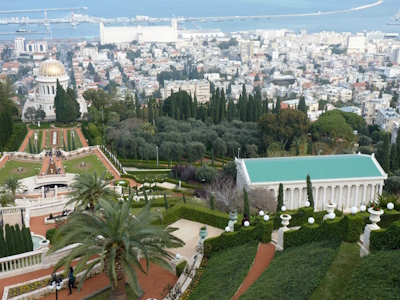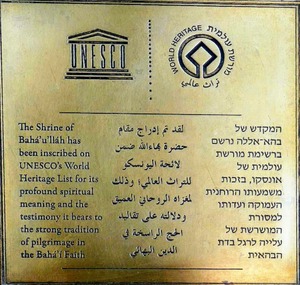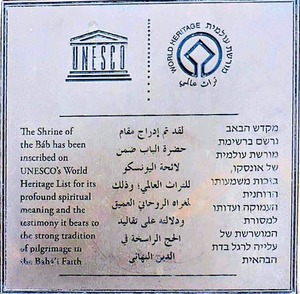Bahá’i Holy Places

The Bahá’i Holy Places in Haifa and the Western Galilee represent the Bahá’i faith and their pilgrimage tradition.
The Holy Shrine of Bahá’u’lláh and the Holy Shrine of the Báb are the most holy places of the Bahá’í faith. They are also directly linked to the faith’s two founders, originating from 19th-century Persia. The sites are an important place of pilgrimage for the millions of Bahá'ís around the world.
Community Perspective: The most visited among the 26 included monuments is the prominent Bahá’i temple on Mount Carmel in Haifa, with its impressive terraced gardens. The others are rarely visited and even harder to appreciate for outsiders to the faith. Solivagant has described the ‘problems’ associated with inscribing a site mostly for the value believers placed upon it.

Map of Bahá’i Holy Places
Community Reviews
Ilya Burlak

The World Heritage inscription of the Baha’i Holy Places emphasizes their deep spiritual value and the tradition of pilgrimage in the Baha’i faith. I am not convinced that it counts as Outstanding Universal Value, but the two main compounds mentioned on the inscription, one in the center of Haifa and one on the outskirts of Acre, also happen to be fine examples of formal gardening, which makes at least the one in Haifa a nearly must-see on any itinerary in Israel. I stopped by both in November 2019.
My expectations for a visit to the Haifa’s Baha’i Gardens included the key assumption that I would be able to enjoy walking in the gardens on my own – and although I had sufficient number of warnings from the interwebs and from my Israeli relatives that that was not the case, it came as a huge disappointment when I finally realized that I could not do that.
Baha’i Gardens in Haifa sit on a steep side of a mountain. The central part surrounding Shrine of Bab is open to visitors from 9am to 12noon daily, and there you can experience some of the gardens first-hand. You can access the shrine’s interior as long as you do not photograph anything therein (somewhat uniquely, the guard at the entrance demanded that I physically cover the lenses of my camera with a cap before coming in). It should be said that there is nothing of specific note to photograph inside the shrine anyway; it has the feel of a sparsely-decorated mosque. You cannot access the sloping garden terraces without a guided tour; free tours in several languages are offered once a day each from the topmost part of the gardens, but none of the English, Russian, or even Hebrew-language tours fit into my itinerary time-wise. Without that, all I could do was to separately visit the uppermost and the lowermost viewpoint areas that allow panoramic views of the gardens; those viewpoints are open from 9am to 5pm.
The gardens in Acre are much flatter in topography and significantly less impressive. You can access the outer gardens through the day, but the inner part around the shrine is also only open to visitors from 9am to 12noon, and then there is a part of the overall complex that is out of bounds until after 12noon. The focal point of the inner gardens here is visually understated Shrine of Baha’u’llah, where you get a short free lecture about the life and times of this founder of the religion before you enter. There are a few decorations inside and you can take a quick peek at the tomb of Baha’u’llah, but again, nothing too surpassing of value and no photography is allowed anyway.
My overall visit to the gardens in Haifa lasted about an hour and a half, including driving between the three points of access. In Acre, I was in and out in less than half an hour, barely squeezing in to see the shrine at the last possible second. I have a tinge of regret that I did not plan on including a guided tour of the gardens in Haifa, and will probably come back for that in the future.
Read more from Ilya Burlak here.
Matejicek

I will add nothing new with my review: This place is shiny and monumental, but it is only a sterile tourist trap. I did half a day trip to Haifa from Tel Aviv 3 years ago, and was very disappointed. Not only by the temple but also by the city of Haifa. Only positive thing I would like to stress was the magnificent view from the site towards the bay of Haifa, and a delicate atmosphere inside the shrine (at the entrance to the shrine, which si the most important place of this religion, a guide - handsome guy - told me the basic data about the religion and other useful information). Nevertheless, I would rather stay in Tel Aviv anyway. Only reason for me to visit Haifa again in the future would be the stay at the world-famous Technion Institute located furher uphill...
GabLabCebu

WHS#53
I visited Haifa on the way to the Galilee in April 2018, and obviously, I had to check out the Bahai Gardens the city is best known for. With a private driver-guide, I was able to see the gardens and the Shrine of Bab both from above and from below. Needless to say, it's a stunning sight to see, and there isn't really any place like this in the world. The gardens show some influence from Persia, where the religion was actually founded, but without the Islamic elements. The Shrine of Bahaullah in Acre seems to also have the same style. Part of the reason it looks so great and shining and pristine, however, is the reason why it might not be a very worthy WHS. The Shrine of Bab was completed in 1953, 55 years before it was inscribed, and the gardens only in 2001, 7 years before inscription. It is clearly a modern site, and although it has huge religious significance, doesn't actually have historic value. Sure, the many serial sites that trace the journey of the Bahai religion's proponents do have a history as an itinerary, but I'd think the sites in Iran and elsewhere should hold the same significance. The sites here in the Galilee are simply pilgrimage sites due to significant figures of the religion being buried here, but they aren't any different from the countless pilgrimage sites in Europe and the Holy Land. The shrine and its gardens make great tourist attractions, and they do have great religious significance and reflect some cultural traditions of its Iranian origin, but overall, it's not really enough to convince me that it's worthy of its WHS title.
Gary Arndt

I have visited the Baha'i Holy Places twice now, and both times I've had limited access to the gardens in Haifa. Really just bad luck.
The gardens are beautiful and are one of the top attractions for tourists visiting Haifa. At the top of the gardens, you get a great view of the entire city and the harbor.
The view from the bottom of the gardens at night is spectacular and it is a great place to eat in the evening as well.
Make sure to check before you arrive as to the operating hours of the garden and if there are any holy days or other special events going on. On my first trip I could only take photos through the gate. On my second trip, I could only visit a limited part of the garden.
Pavel Matejicek
I visited the gardens and shrine in Haifa and I agree with the reviews below: There is a great view over the Haifa bay and the place itself looks spectacular, but I cannot see any OUV there.
In summary: it is a tourist trap, I can see reason of inscription only to attract the tourist for visiting of Haifa, that is perfectly located but do not offer anything that can be called as a world class site.
Solivagant

We had intended trying to fit in several of the 11 locations at Haifa and Akko within this inscription but, in the end, time constraints limited us to the North Slope of Mt Carmel and its structures - or such as non-believers are allowed to see/enter!! So this means the Terrace Gardens and external views of the Shrine of the Bab together with the “Arc” of administrative buildings which are situated next to the terraces (The Seat of the Universal House of Justice, Seat of the International Teaching Centre, the International Archives and the Centre for the Study of the Sacred Texts).
The Terraces were built as recently as 1990-2001 whilst the Arc buildings date to the 1950s through to the 1980s. The shrine itself dates back to an original “simple” building from 1899-1909 but was given its current grandiose appearance with gold dome and Corinthian columns between 1948/53. There is no doubt that the terraces are “impressive” for their grandiosity, climbing some 225 metres in 1 km, particularly when seen from the bottom (at top end of Ben Guirion St, Haifa’s - main restaurant area). Having seen them from the bottom in the evening (visitors are allowed to ascend just to the first “balcony”) we went to the top the next day and planned to take the noon English tour down through the gardens. There you can again freely descend to the first “balcony” without taking a “tour”. The view from the top over Haifa is fine but no better than from other places along the same road. The view down the terraces themselves I didn’t find as impressive as looking up.
I wish we had limited our visit to these 2 easily accessible areas, but we decided to go for the noon tour even though one can no longer book them. We actually arrived at 10.55 from out of town and found just a handful of people waiting for the 11am Hebrew tour. So we decided to have a look around the top area first and come back at 11.25 to start queuing for the English tour. BIG mistake!!! When we returned, there were well over 100 Russians/Japanese and assorted other nationalities from coach tours all waiting for an English language tour limited to 60 people! At least they didn’t shut the door after the first 60 but it was 12.40 before we got in on a Hebrew language tour we could have gone on 1 hr 40 minutes earlier! Moral – take the first tour you can get and the English language tour is primarily filled with non Hebrew speakers who may or may not speak English! In fact we were given a little brochure in English, the guide had relatively little to say anyway and was able to answer questions in English if asked. Bear in mind that the tour finishes half way down the terraces from where we had to return to our car at the top by road (not as direct as the way down!) on foot or by taxi!
Perhaps I was no longer mentally attuned to appreciating what I was seeing but I found the series of identical balconies with their similar gardens and cheap looking red gravel rather boring – especially as the shrine we were approaching was closed to us anyway. January may not have been the best time to see the gardens even in Israel and large areas were looking a bit thin. This is no “Generalife”, despite the fountains and running water. The buildings making up the “Arc” were pompous copies of classical structures - or perhaps pompous copies of US copies of classical structures? In any case they did not impress.
It is interesting to read the ICOMOS evaluations of the nomination – the first for the 2007 WHC which “referred” it and the second for the 2008. The first concluded that the nominated buildings really had no architectural merit at all (“The OUV of the collection of buildings cannot be justified in terms of their intrinsic historical, artistic or scientific merits”). Such merit as the entire collection possessed related solely to the value placed upon them by the Bahai faith – which ICOMOS didn’t feel qualified to pass judgement on!! As such, only criterion vi could even be considered appropriate (“Directly or tangibly associated with .. beliefs and traditions” etc) which was a problem as the WHC didn’t like inscriptions on vi alone and ICOMOS didn’t consider that criterion iii was met! One year later both iii and vi were considered appropriate although, since the only changes to the nomination were to matters of management and protection plus some additional “arguments”, it is difficult to see why the ICOMOS view of iii changed.
Clearly there is a problem evaluating sites in terms of OUV when their value is primarily/solely to the religion they represent – with their inscription on the basis of just criteria iii and vi the Bahai holy places are in the same company as Lumbini, Fujisan and Sulaiman-too. But where should UNESCO stop in trying to be even handed towards the central sites of all religions and cultures irrespective of their artistic/architectural merit? The Cao Dai temple in Tay Nihn? The Mormon Tabernacle (there are 3 times as many Mormons in the world as Bahais)? Gapyeong Unification Church? The major centres of Scientology in US/UK?
The Bahai religion generally gets a “good press” with its messages of equality, universality and peace and the discrimination against its adherents in many countries past and present. There doesn’t seem much to oppose in fact!! But one thing does surprise me – its approach to Israelis both in Israel and elsewhere - “in keeping with a policy that has been strictly followed since the days of Bahaullah, Baha'is do not teach the Faith in Israel. Likewise, the Faith is not taught to Israelis abroad if they intend to return to Israel”…….”whenever an Israeli citizen living in the West, irrespective of his background and religious affiliation, declares his belief and interest in becoming a member of the Baha'i community, he should be informed that the Faith is not taught in Israel and that there is no Baha'i community there apart from those who are associated with the Baha'i World Center. He cannot be accepted into the Baha'i community if he is planning to return to Israel to reside there. If he plans to continue to reside outside Israel, his enrollment can be accepted, but he will then be subject to the same restrictions about travel to Israel as any other Baha'i, in that he could do so only with the express permission of the Universal House of Justice. In any event, the Universal House of Justice should be informed of any such declaration” Very strange! I can’t work out how much this is driven by Bahais, or how much is a tacit agreement with Israel to avoid upsetting the status quo regarding the Bahai “use” of Israel for its Holy Places.
(PS - some years later we visited (within the limits of what was accessible) the sites in Akko (In the City and Bahji) - but discovered no reason to alter our general assessment of this WHS)
Tony H.
I had bad luck with my visit to Baha'i gardens and the Shrine of the Bab in Haifa. Gardens are closed if it's rainy day (because the stairs are really slippery when they're wet) and it was raining every morning of my stay so the gardens stayed closed. The shrine was also under construction so the site wasn't that impressing looking.
In my visit to Akko I took the local bus to Bahje house and the Baha'i gardens around it. The house, which was the home of Baha'ullah, is open only in the morning (for Baha'is it's always open) so it was closed when I visited it in the afternoon. You get the see the gardens outside which were very clean and straight like the ones in Haifa. Doorman at the gate gives you an information leaflet in your own language (he said they have it in every language, I doubt it). The Bahje house looks like any other Mediterranean mansion built in the 1800s. More interesting was to watch the pilgrims going to see the holiest place of their religion. I think that if you like gardens this place is worth of visit, by bus it was only 10 minutes from Akko.
DAB

I only visited the most famous part of this complex: the Shrine of the Bab and the Persian gardens which surround it (in Haifa). It is a peacefully, pretty place. The gardens are terraced, which makes them look neat from both above and below. A profusion of purple a green colours greet the visitor. The gardens are great, and make good use of the path in the artistic beauty, something not seen everywhere. The view from the gardens over Haifa, and the plains and mountains of Israel is one of the best views you will ever find in Israel.
On to the Shrine, which pales in comparison to the gardens. It is a nice, elegant building: but not spectacular, it would not top anyones list of most amazing buildings. However it is situated in the best possible spot in relation to the gardens. This makes a complete picture of loveliness. This site deserves its inscription on the World Heritage List mostly on its importance to the Baha'i Faith, not its architectural merit (although I think the garden could hold up to the best in the world).
This site however is quite easy to visit while one is in Israel. Israel is a small country, and Haifa is only 1 hour from Jerusalem, and less from Tel-Aviv. Israel is a wonderful country and I highly recommend a visit!!!!
Assif
The only Bahai site in Israel I've been to is the Bahai Temple in Haifa. It's situated atop the Carmel and overlooks the harbour and the German Colony. The gardens follow the "falling" type, meaning they literally cover the entire sloap of the mountain. You need to reserve a guided tour in which you get to hear about the Bahai faith. This is the only way to visit the site but these visits cost nothing. Disappointingly, you are only allowed to step downhill as stepping uphill is reserved for Bahai pilgrims.
Community Rating
- : Maxine Eisenberg Koen Vliegenthart WalGra Travelure AndreaTLV Can SARICA Bergecn Zsuzsanna Forray
- : Persian Globetrotter K2flake
- : Jan Zimmermann Hughes1920 George Gdanski Juropa Londonium Xiquinho Silva Jsobel21 Jsrinivasan João Aender Dirk-pieter
- : Tarquinio_Superbo Dorejd Yongcheng Liu Seadie Christravelblog Cmtcosta Roman Raab Tony0001
- : Craig Harder Ralf Regele Philipp Peterer Hanming Boppare Cezar Grozavu Cody Ayers Ivan Rucek
- : Szucs Tamas DAB Adrian Turtschi Tony H. Wojciech Fedoruk Eatexplore57 Javier Lucio Gorla Daniel C-Hazard Mikko TheShabe Csaba Nováczky
- : Walter Stanislaw Warwas Vernon Prieto Jon Opol Gary Arndt Sncjob Dennis Nicklaus Martina Rúčková Bernard Joseph Esposo Guerrero
- : Els Slots Nan Zoë Sheng Philipp Leu Ilya Burlak
- : Matejicek Don Irwin GabLabCebu Ssong.x
- : Solivagant Alexander Parsons Alexander Lehmann Assif Argo
Site Info
- Full Name
- Bahá’i Holy Places in Haifa and the Western Galilee
- Unesco ID
- 1220
- Country
- Israel
- Inscribed
- 2008
- Type
- Cultural
- Criteria
-
3 6
- Categories
- Religious structure - Bahá'i Faith
- Link
- By ID
Site History
2008 Inscribed
2007 Referred
Re-consider its scope and put in place stronger protection
Site Links
Unesco Website
Official Website
In the News
Connections
The site has 23 connections
Art and Architecture
Constructions
Geography
Human Activity
Individual People
Religion and Belief
Timeline
Trivia
Visiting conditions
WHS Hotspots
WHS Names
World Heritage Process
Visitors
280 Community Members have visited.

